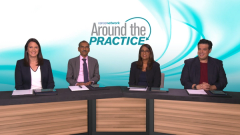
Patient Case 1: A 54-Year-Old Woman With Transplant-Eligible NDMM
Opening their discussion on the first patient case, expert panelists review the management of transplant-eligible newly diagnosed multiple myeloma.
Episodes in this series

Transcript:
Sundar Jagannath, MD: Welcome to this Cancer Network Around the Practice program titled Recent Advances in Multiple Myeloma: Insights from Experts at The Mount Sinai Hospital [New York, NY]. I’m your host, Sundar Jagannath. I am the director of the Center of Excellence for Multiple Myeloma and a professor of medicine at the Tisch Cancer Institute. I have a great panel of experts who have joined me today. I would like to invite my esteemed fellow panelists to introduce themselves.
Adriana Rossi, MD: Hi, I am Dr Adriana Rossi. And together with Dr Shambavi Richard, the co-director of the stem cell and CAR-T [chimeric antigen receptor T cell] program at the myeloma program.
Shambavi Richard, MD: Hi, I’m Dr Shambavi Richard. I’m an associate professor of medicine. And as Dr Rossi said, we co-lead the myeloma cellular therapies and CAR-T program together.
Joshua Richter, MD:I’m Dr Joshua Richter. I’m an associate professor of medicine and the director of myeloma at the Blavatnik Family Chelsea Medical Center at Mount Sinai, with an interest in bispecific antibodies.
Sundar Jagannath, MD: Thank you all for joining me today. We are going to discuss several key data updates in the multiple myeloma treatment landscape from the International Myeloma Society’s 2022 annual meeting, [Los Angeles, CA], and other recent meetings. We will review these data in the context of 3 clinical cases and discuss how we can apply recent evidence to our clinical practice to improve patient outcomes. Let’s begin. Dr Richard, could you kindly present the first case?
Shambavi Richard, MD: I’ll start by presenting a case of a newly diagnosed transplant-eligible patient who was high risk. This is a 54-year-old woman who presented with back pain and anemia with a hemoglobin of 8.8 on April 29, 2020. Here are the lab statistics. The M (monoclonal)-spike was 6.4 grams [g] per dL; the IgG was 8.4g/dL. The lambda light chain was 1800 milligrams [mg] per liter with a kappa lambda ratio of 0.01. The beta-2 microglobulin was 11.2; the serum albumin was 3 g/dL. The corrected calcium was 11 mg/dL, and the serum creatinine was 1.14 mg/ dL. The bone marrow biopsy showed 50% to 60% lambda-restricted plasma cells. And FISH [fluorescence in situ hybridization]studies showed deletion 13q14 and a translocation 4;14. A CT scan of the chest, abdomen, and pelvis had shown diffuse lytic foci throughout the structures, with paraspinal soft tissue mass of T7 to T10, and a loss in height of multiple vertebral bodies. She was staged as a RISS [Revised International Staging System] stage 3 IgG lambda multiple myeloma. She was high risk due to a translocation 4;14. She received pulse dex [dexamethasone] 40 mg for 4 days and then XRT [external beam radiation] from T6 to T11 in the spine. There was a total dose of 3000 centigrade 10 fractions between May 14 and 28 of 2020. She then came to Mount Sinai Hospital. She was in pain when she came in. She was in a wheelchair and she decided to transfer her care over to Mount Sinai. We started with dara [daratumumab]-VCd [bortezomib (Velcade), cyclophosphamide, dexamethasone] for 1 cycle while waiting for lenalidomide’s [Revlimid] approval. And then dara-VRd [bortezomib, lenalidomide, and dexamethasone] was started on July 1, 2020, of which she received 4 cycles. She started zoledronic acid 4 mg monthly simultaneously. She did have kyphoplasty, T7 to T12, but by the end of her induction, she was not in pain and no longer needed a wheelchair. Here are the MRI images at diagnosis on the left and after completion of her induction treatment on the right. You can see the diffuse osseous lesions and the significant improvement post-kyphoplasty and treatment on the MRIs. Restaging post the 4 cycles of dara-VRd induction showed her bone marrow to be negative for coronal plasma cells. Her MRD [minimal residual disease] was negative by next generation flow and her PET/CT [positron emission tomography-computed tomography scan] was negative as well. She then had stem cell harvest followed by a high dose of melphalan 200 milligrams per meter squared [mg/m²]. Followed by an autologous stem cell transplant in December 2020. 100-day restaging showed her to be in stringent CR [complete response], MRD was negative and PET/CT was negative. Maintenance was started with bortezomib every other week and lenalidomide 10 mg daily, 21 out of 28 days. She was trying to switch to ixazomib [Ninlaro] and lenalidomide for convenience, as she had also started to develop myo-neuropathy symptoms. [And] was unable to tolerate it due to GI [gastrointestinal] side effects. At that point, she was taken off and resumed back on the bortezomib. Restaging at 1 year of maintenance in April of 2022, continue to show stringent CR, bone marrow negative, MRD negative, and PET/CT negative. Bortezomib was stopped at that point due to continued neuropathy and she continues with lenalidomide maintenance.
Sundar Jagannath, MD: Very good. Let me introduce some of the induction therapy that we are using today, especially in transplant-eligible patients. We talk about triple therapy, and we talk about quadruple therapy. Triple therapy, generally we talk about Velcade, Revlimid, and dexamethasone. And the quadruple therapy we talk about adding daratumumab to Velcade, Revlimid, and dexamethasone. People also use CyBorD [cyclophosphamide, bortezomib, and dexamethasone] in the induction phase, and in Europe they’ve also used VTD [bortezomib, thalidomide, dexamethasone].
Transcript edited for clarity.
Newsletter
Stay up to date on recent advances in the multidisciplinary approach to cancer.










